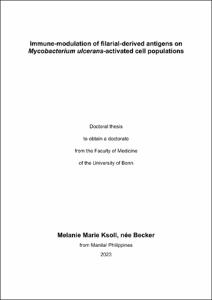Immune-modulation of filarial-derived antigens on mycobacterium ulcerans-activated cell populations

Immune-modulation of filarial-derived antigens on mycobacterium ulcerans-activated cell populations

| dc.contributor.advisor | Hörauf, Achim | |
| dc.contributor.author | Ksoll, Melanie Marie | |
| dc.date.accessioned | 2023-09-25T10:16:26Z | |
| dc.date.available | 2023-09-25T10:16:26Z | |
| dc.date.issued | 25.09.2023 | |
| dc.identifier.uri | https://hdl.handle.net/20.500.11811/11064 | |
| dc.description.abstract | Buruli ulcers disease is a neglected tropical disease, caused by Mycobacterium ulcerans, that affects skin and sometimes bones and can lead to large, disfiguring skin ulcers and sometimes long-term disability. So far, it remains unclear why some people develop the disease and what factors influence its outcome, but previous studies suggest that a strong TH1-based immune response has a protective effect. Buruli ulcers disease is co-endemic with filarial infections which are often asymptomatic and can persist for many years. Very little is known about the effect of a co-infection with these two infections, but helminths are known to be able to polarize different immune responses. Therefore, the present thesis aimed at analysing the onsequences of such co-infections by studying the effects of filarial antigen on M. ulcerans-activated cell populations exvivo. Within this thesis immune profiles of different immune cells upon stimulation with antigen extract generated from M. ulcerans (BuAg) were established and it was shown that the BuAg-induced pro-inflammatory immune response in bone-marrow derived dendritic cells (BMDC) was TLR2-dependent. The murine filarial infection model with L. sigmodontis and an antigen extract generated thereof (LsAg) were employed to study the potential effect of filarial infection on infection with M. ulcerans. Results from costimulation with filarial antigen showed that Bu-Ag induced responses in BMDC were unaltered in the presence of filarial-antigens or live worms while immune responses in spleen cells were dampened. Further work described in this thesis analysed the effect of filarial infection on BuAg induced responses ex-vivo and revealed dampened TH1, and most importantly IFN-γ responses, which appeared to be reinforced by but not dependent of patency of the filarial infection. Overall, these data substantiate the hypothesis that filarial infection may influence the development and outcome of Buruli ulcers disease. Further research into these aspects might broaden the understanding of this neglected disease and help with its prevention and treatment. | en |
| dc.language.iso | eng | |
| dc.rights | In Copyright | |
| dc.rights.uri | http://rightsstatements.org/vocab/InC/1.0/ | |
| dc.subject | Mycobacterium ulcerans | |
| dc.subject | Buruli Ulkus | |
| dc.subject | Litomosoides sigmodontis | |
| dc.subject | Filariose | |
| dc.subject | Co-Infektionen | |
| dc.subject | Immunmodulation | |
| dc.subject | mycobacterium ulcerans | |
| dc.subject | Buruli ulcer | |
| dc.subject | litomosoides sigmodontis | |
| dc.subject | filariasis | |
| dc.subject | co-infections | |
| dc.subject | immune-modulation | |
| dc.subject.ddc | 610 Medizin, Gesundheit | |
| dc.title | Immune-modulation of filarial-derived antigens on mycobacterium ulcerans-activated cell populations | |
| dc.type | Dissertation oder Habilitation | |
| dc.publisher.name | Universitäts- und Landesbibliothek Bonn | |
| dc.publisher.location | Bonn | |
| dc.rights.accessRights | openAccess | |
| dc.identifier.urn | https://nbn-resolving.org/urn:nbn:de:hbz:5-72494 | |
| ulbbn.pubtype | Erstveröffentlichung | |
| ulbbn.birthname | Becker | |
| ulbbnediss.affiliation.name | Rheinische Friedrich-Wilhelms-Universität Bonn | |
| ulbbnediss.affiliation.location | Bonn | |
| ulbbnediss.thesis.level | Dissertation | |
| ulbbnediss.dissID | 7249 | |
| ulbbnediss.date.accepted | 06.09.2023 | |
| ulbbnediss.institute | Medizinische Fakultät / Institute : Institut für Medizinische Mikrobiologie, Immunologie und Parasitologie (IMMIP) | |
| ulbbnediss.fakultaet | Medizinische Fakultät | |
| dc.contributor.coReferee | Franklin, Bernardo Simões |
Dateien zu dieser Ressource
Das Dokument erscheint in:
-
E-Dissertationen (1998)




